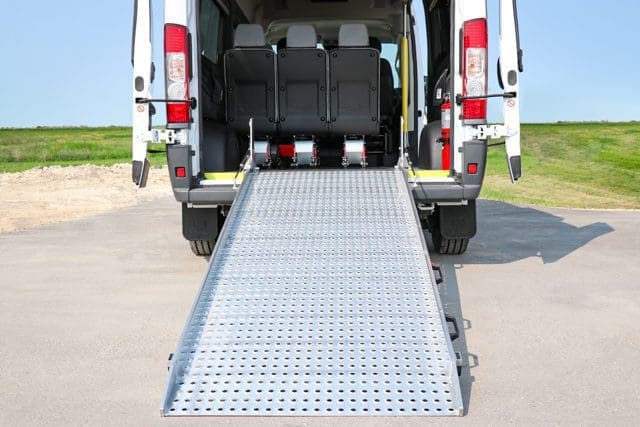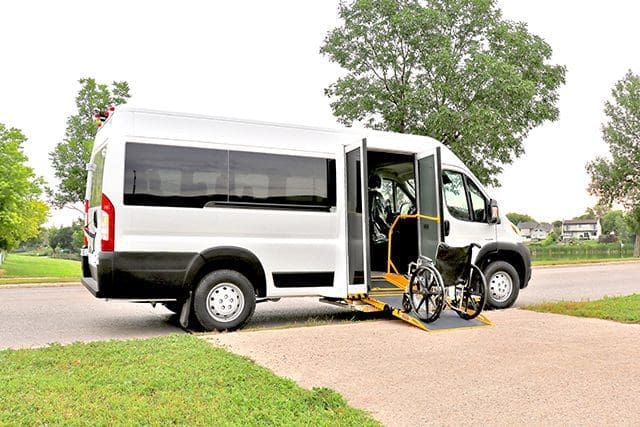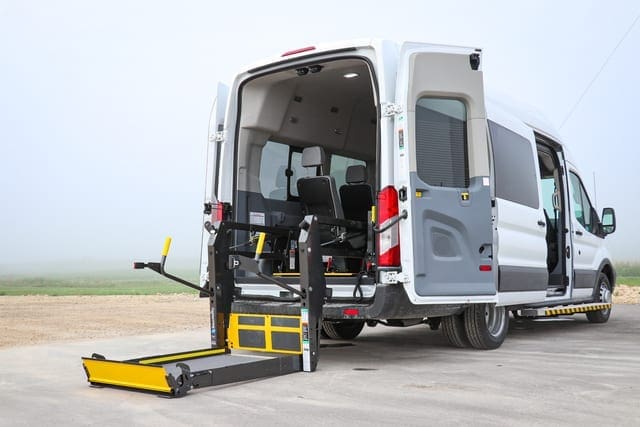Have you ever wondered what wheelchair ramp slope really means? You’re likely not the first. Many organizations shopping for a wheelchair van get stuck on this term, especially when they hear “4:1 slope.” It sounds confusing, but it’s actually quite important.
If you don’t understand wheelchair ramp slope, you could pick a ramp that’s too steep or unsafe. That means clients or patients could struggle or even get hurt. You want comfort, safety, and dignity for the people you serve. The right ramp slope helps make that happen. When you understand what 4:1 means, you can choose the right van and feel confident knowing your ramp makes life easier.
At MoveMobility, we’ve spent over two decades building wheelchair vans for organizations like yours that aim to break transportation barriers all over Canada. Our vehicles meet strict safety rules with Ford QVM and Stellantis QPro certifications, plus the National Safety Mark. We work with organizations like yours from Vancouver to St. John’s because no two communities are the same. And while we know our stuff, this guide isn’t about selling you, it’s about helping you make the best choice.
In this article, you’ll learn:
- What 4:1 wheelchair ramp slope means
- Why slope matters for safety
- How to pick the right wheelchair accessible ramp slope
- When to use a wheelchair ramp slope calculator
4:1 wheelchair ramp slope: What does it mean?
A 4:1 wheelchair ramp slope means that for every 4 inches of ramp length, the ramp rises by 1 inch. That’s it. Simple, right? But this small ratio makes a big difference for people using wheelchairs or mobility aids.
Think of it like this: if you need to get up a 4-inch step, your wheelchair van ramp must be at least 16 inches long to keep that 4:1 slope safe and easy to use. If the ramp is shorter than that, it will feel too steep and can be unsafe.
A wheelchair-accessible ramp slope like 4:1 is common in vans or mobile medical units where space is tight. You see this kind of slope often in places where the ramp can’t be super long, like mobile clinics that park downtown in cities like Toronto or Vancouver, where space is limited.
So why should you care about the slope for a wheelchair ramp? Because it changes everything about how easy and safe the ramp feels for the person using it.
Here’s why this matters to you:
- Comfortable use: A 4:1 wheelchair ramp slope lets users or caregivers move smoothly, without feeling like they’re pushing up a hill.
- Safety: A slope that’s too steep can lead to falls, slips, or tipping.
- Space-friendly: A 4:1 slope works well in places where a long ramp isn’t possible.
But keep in mind, this slope is best for short, portable ramps, not for permanent building ramps, which usually need a gentler slope.
Want to be sure about your ramp length? A wheelchair ramp slope calculator can help. You plug in the height, and it tells you exactly how long the ramp should be to stay safe.
When you hear 4:1, think safe, compact, and easy to use.
The importance of wheelchair ramp slope for ensuring safety

The wheelchair ramp slope you choose isn’t just about fitting a ramp into your van. It’s about safety, comfort, and protecting the people who rely on your services. A steep slope can make life harder for your clients and even dangerous.
Imagine this: your client rolls toward the ramp. If the slope for wheelchair ramp is too steep, they could lose control going down. Going up could feel like a struggle, leaving them tired or even stuck halfway. That’s scary and frustrating for anyone using a wheelchair, especially older adults or those with limited strength.
A safe, wheelchair-accessible ramp slope prevents this. It keeps the ride smooth, stable, and stress-free for everyone involved. Caregivers pushing wheelchairs also feel the difference. A proper slope means less effort, fewer risks, and less chance of muscle strain or injury.
Here’s why the right wheelchair ramp slope really matters:
- Reduces injury risk: A steep ramp can lead to tipping or falling. A gentle slope keeps the ride safe and balanced.
- Improves independence: Some users prefer to move on their own. The wrong wheelchair accessible ramp slope forces them to rely on others.
- Protects caregivers: Pushing up a steep ramp can strain shoulders, backs, and arms.
- Keeps equipment working longer: A gentle slope for a wheelchair ramp is easier on powered chairs and scooters, preventing wear and tear.
If your manufacturer or whoever you’re purchasing a wheelchair van from gets the slope wrong, the whole van becomes harder to use, maybe even impossible for some clients. But when you get the wheelchair ramp slope right, your van becomes a safe, trusted part of their daily routine.
This is why thinking about slope early saves stress later.
How do you choose the right wheelchair accessible ramp slope?
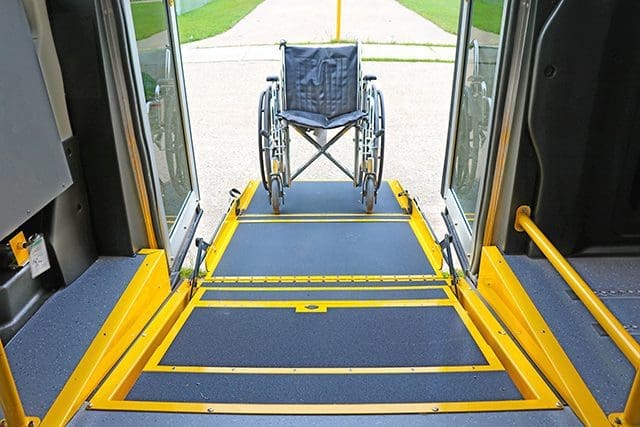
Choosing the right wheelchair accessible ramp slope can feel tricky, but it’s super important if you want your van to be safe, easy to use, and built to last. The slope you need depends on who’s using the ramp, how often, and what kind of space you’ve got to work with.
If you’re buying a brand new van from a trusted builder like MoveMobility, you don’t have to worry. We make sure the wheelchair ramp slope meets safety standards every time. But if you’re thinking about buying used from another owner or a dealer, you really have to pay attention to the slope of the wheelchair ramp. The last owner may have installed a ramp that worked for their needs, but not for yours.
Here’s how to pick the right slope
- Know your user’s needs: Is the person using a manual chair, power chair, or scooter? Manual chair users may need a gentler wheelchair accessible ramp slope than someone using a powered chair.
- Measure the entry height: Use a wheelchair ramp slope calculator like the one we mentioned earlier to determine the length of your ramp for safe use. If the van’s floor is 8 inches high, for example, you’ll need at least 32 inches of ramp length for a 4:1 slope.
- Think about the caregiver: If a caregiver is helping, a steeper slope might still work. But if the user wants independence, a gentler wheelchair ramp slope makes more sense.
- Check local rules: Canada has different codes for public buildings, but vehicle ramps are different. Still, safety matters no matter where you are, whether it’s downtown Calgary or rural PEI.
At MoveMobility, every van we build follows trusted safety standards and guidelines. You’ll never have to second-guess the wheelchair ramp slope when you work with us. But again, if you buy used, double-check the ramp measurements so you don’t get stuck with something unsafe or frustrating.
Are you having trouble deciding between a ramp and a lift? Check out our comparison article or video below.
How come used wheelchair vans might have the wrong ramp slope?
Let’s circle back to used wheelchair vans for a minute. One of the biggest risks is the wheelchair ramp slope.
When a van is built for its first owner, especially if you’re purchasing from someone on a platform like Marketplace, the ramp is often designed to fit that person’s specific needs. But those needs may not match yours. The slope might be too steep, too short, or just plain unsafe for your clients or program. Many organizations overlook this, and it can cause real problems down the road.
Here’s why the wheelchair accessible ramp slope on a used van might not work for you:
- Designed for someone else: Maybe the previous owner used a powered chair, but your clients use manual chairs. A slope that worked for them may be too steep for your clients.
- Modifications you don’t know about: Some owners change the ramp without following safety standards. You could end up with a risky and steep slope for wheelchair ramp without even knowing it.
- Wear and tear: Over time, ramps bend, loosen, or sag. This can mess up the original safe wheelchair ramp slope, making it steeper or unsafe.
A steep or awkward ramp can lead to:
- Client frustration: If the slope is wrong, clients may feel unsafe or embarrassed.
- Caregiver strain: Pushing up a bad wheelchair accessible ramp slope is tough work.
- Accidents or damage: Bad slopes increase the chance of tipping or wheel problems.
When you choose MoveMobility, this worry disappears. Our new vans meet strict safety standards, including proper wheelchair ramp slope, so you don’t have to second-guess.
If you’re still fixed on buying used, always measure the ramp. It’s a small step that can save big headaches.
Got any questions about 4:1 ramp slope?
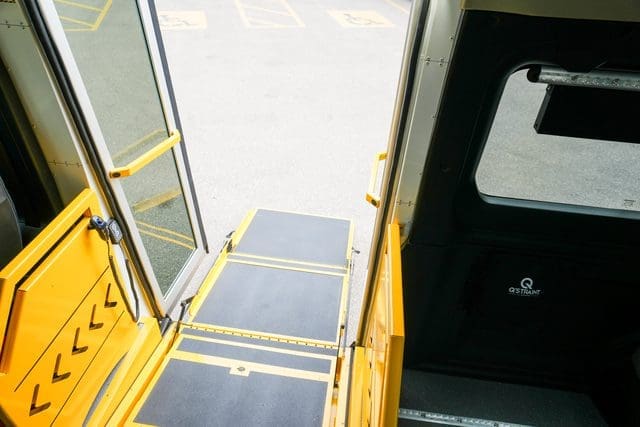
You likely landed on this article because you wanted to know why the right wheelchair ramp slope matters so much. If you’ve made it this far, here’s a quick recap of what you learned:
- 4:1 slope basics: what it means and why it matters for safety.
- Used van risks: how an unverified wheelchair accessible ramp slope can harm clients or staff.
- MoveMobility’s solution: we guarantee proper ramp slope so you get a safe, reliable vehicle.
At MoveMobility, we’ve built hundreds of vehicles with precisely measured slopes for wheelchair van ramps tailored for real-world Canadian use, from Vancouver’s hills to Winnipeg’s winters. Our ramps are tested under actual load and terrain, letting you focus on care, not repair. We care deeply about your success, your clients’ dignity, and safe transport. If you’d like to chat, click below to speak with a mobility expert who can guide you through your options.
If you’re not ready to talk yet, check out these useful articles to help you learn more and make confident choices:
- How to choose a wheelchair van (11 steps): This guide walks you through the full decision-making process, from needs to delivery.
- Manual ramps for wheelchair vans: You’ll find useful insights on manual ramps to determine if they’ll work for you.
- 5 Ways to reduce the wheelchair ramp slope on wheelchair vans: This article shows simple solutions to improve the slope and usability.
These articles will help you feel confident as you move toward purchasing a van that truly fits your clients’ needs.


